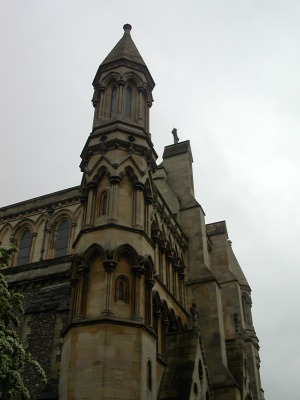
Another day out. I could get to like this. My friend Alison White wanted me to meet her mother, who lives over here, and we decided to meet in St Albans, formerly the Roman city of Verulamium, even more formerly the Catuvellauni stronghold of Verlamio. Americans never quite get over how bloody old everything is over here. We live with a persistent notion that our country emerged from the brow of John Adams, et al, in 1776, and before that there just wasn’t anything. (Steve Martin, showing Victoria Tennant around Los Angeles in L.A. Story: “Some of these buildings are more than twenty years old!”). We all have to take American History in high school, but in my time at least, it was only the history of Europeans in America, which they could have covered it in six weeks and let everyone go home early.
Our plan was for lunch and a walk around the Verulamium Roman museum and the ruins of an amphiteatre that were somewhere about. We did get to the museum eventually, but skipped the amphiteatre on account of rain. Carolyn, along with John Thurgood, picked me up at St Albans rail station. Carolyn and John are delightful, warm, intelligent people, and I felt welcomed the moment I stepped through the station turnstile. We spent a chatty and companionably long lunch hour at a 700-year-old pub, the Old Tudor Tavern. Carolyn obtained some history from the bartender: The place was formerly two coach inns, the Swan and the George, and the very beams above our head were original to the 14th century, when pilgrims on their way to the monastery and cathedral stopped here. You had to be somebody important to stay at the monastery, so it was surrounded by inns like this one for the rest of us, around which the present town grew up. We were parked near the cathedral, so we decided to check that out first and find the museum later.
We had only been wandering around near the doors a few minutes when John alerted us that a guided tour was about to start, and we joined it. On our own we would probably have spent 30 minutes looking at the architecture and gone on in search of the real reason for the day out – Romans again – but once under the spell of our tour guide, a man who clearly loved this church and all it represented to him, we followed along to the end, which took at least an hour and a half. I won’t tire you with endless details, but a look at the nave will help you understand why we felt compelled to see the rest and listen to our guide’s seemingly endless store of historical anectdotes.
The longest and highest church nave in Britain is no-nonsense 11th century Norman architecture on one side, with faded frescoes on every pillar, and elaborate 14th century gothic stonework on the other side, owing to a partial collapse and rebuilding. In some places along the older side, parts of gothic arches emerge out of Norman plaster walls as though planned by some distant ancestor of H.R. Giger.
The original church, dating to the 8th century, was built around a shrine housing the remains of St Alban, the first British martyr. A wealthy Roman citizen, Alban had given his life in place of that of a Christian priest under his protection. There’s a very brave story involved, which is probably apochryphal, but that’s not the point; the point is that it is a brave story, full of compassion and selflessness, and it moved people. In addition to lots of other, more self-serving reasons, people journeyed here to touch the mystery of St Alban and be moved. They didn’t have TV, so they couldn’t just stay home and watch American Idol as one does in these more enlightened times.
In 1539 the Catholic church was outlawed in England, and the monks fled, one with a bag hidden inside his robe containing the bones of St Alban. The bones ended up in Germany, and would not return until about twenty years ago. The shrine that had housed them for centuries before the Reformation, a delicately-pillared structure of Welsh marble, was broken up into about 2000 pieces and hidden in nearby walls. Its location was forgotten, and when some of it was found by accident during the 20th century, the rest was recovered from hiding and painstakingly reassembled in a process that took a team of archaeologists more than ten years. It now rests on a dais in its own chapel, surrounded by an iron railing, still overlooked by a 700-year-old carved oak hiding place where monks once watched to make sure pilgrims’ gifts remained unmolested.
At the end of our tour, our guide explained that he was a Roman Catholic who held some office or other in a very ecuminical Anglican cathedral, and by exercising his priveleges (after apologizing for a demonstration of excess pride) he could allow us to touch the shrine. He opened a gate and we filed inside. I placed my hand on something created when my ancestors were driving the Vikings back to Dublin, something that had drawn people from all over Britain to St Albans in a time when most people never got five miles from the spot where they were born, and I absolutely felt something. All the centuries between those people and me just faded away, and I felt the weight of all those stories. The air around that chunk of carved marble containing a pile of 1600-year-old bones was thick with stories, and for a moment it felt like I was touching all of them. It was a mystical experience of the sort only a person as irreligious as myself could have – a person who holds no faith in Alban’s sainthood in the eyes of a personal God she doesn’t believe in, but is perfectly willing to accept (along with Joseph Campbell) that any place can be holy if you draw a circle around it and say “This is a holy place.”





3 comments:
Beautiful.
sounds like you are having a wonderfull time. Hope it's as fun as it sounds. Can't wait to see you when you get back. Love you much.
Chris
Sounds like your having a great time. I can't wait to see all the lovely pictures when you get back to Seattle. Love you much.
chris
Post a Comment